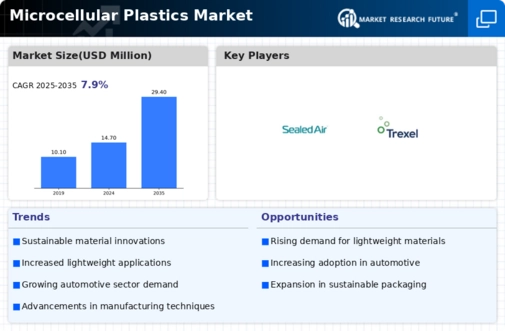-
Executive Summary
-
Scope of the Report
-
Market Definition
-
Scope of the Study
- Research Objectives
- Assumptions & Limitations
-
Markets Structure
-
Market Research Methodology
-
Research
-
Process
-
Secondary Research
-
Primary Research
-
Forecast Model
-
Market Landscape
-
Five Forces Analysis
-
Threat of New Entrants
-
Bargaining
-
power of buyers
-
Threat of substitutes
- Segment rivalry
-
Value Chain/Supply Chain of Global Microcellular Plastics Market
-
Industry Overview of Global Microcellular Plastics
-
Market
-
Introduction
-
Growth Drivers
-
Impact
-
analysis
-
Market Challenges
-
Impact analysis
-
Market Trends
-
Introduction
-
Growth Trends
-
Impact analysis
-
Global Microcellular Plastics
-
Market by Application
-
Introduction
-
Building & Construction
-
Market Estimates & Forecast, 2020-2027
- Market Estimates & Forecast by Region, 2020-2027
-
Automotive & Transportation
-
Market Estimates & Forecast,
- Market Estimates & Forecast by Region, 2020-2027
-
Healthcare
-
Market Estimates & Forecast, 2020-2027
-
Market Estimates & Forecast by Region, 2020-2027
-
Electrical
-
& Electronics
-
Market Estimates & Forecast, 2020-2027
-
Market Estimates & Forecast by Region, 2020-2027
-
Food Packaging
-
Market Estimates & Forecast, 2020-2027
-
Market Estimates & Forecast by Region, 2020-2027
-
Others
-
Market Estimates & Forecast, 2020-2027
- Market
-
Estimates & Forecast by Region, 2020-2027
-
Global
-
Microcellular Plastics Market by Region
-
Introduction
-
North America
- Market Estimates
-
& Forecast, 2020-2027
-
Market Estimates & Forecast by Application,
- US
- Canada
-
Europe
-
Market Estimates & Forecast, 2020-2027
- Market
-
Estimates & Forecast by Application, 2020-2027
-
Germany
- Market Estimates & Forecast, 2020-2027
-
& Forecast by Application, 2020-2027
-
France
- Market Estimates & Forecast, 2020-2027
-
& Forecast by Application, 2020-2027
-
Italy
-
Market Estimates & Forecast, 2020-2027
-
Market Estimates & Forecast
-
by Application, 2020-2027
-
Spain
- Market
-
Estimates & Forecast, 2020-2027
-
Market Estimates & Forecast
-
by Application, 2020-2027
-
U.K
- Market Estimates
-
& Forecast, 2020-2027
-
Market Estimates & Forecast by Application,
-
Asia Pacific
- Market Estimates &
-
Forecast, 2020-2027
-
Market Estimates & Forecast by Application, 2020-2027
- China
-
India
-
Market Estimates & Forecast, 2020-2027
-
Market Estimates & Forecast by Application, 2020-2027
-
Japan
-
Market Estimates & Forecast, 2020-2027
-
Market Estimates & Forecast by Application, 2020-2027
-
Australia
-
Market Estimates & Forecast, 2020-2027
-
Market Estimates & Forecast by Application, 2020-2027
-
New Zealand
-
Market Estimates & Forecast, 2020-2027
-
Market Estimates & Forecast by Application, 2020-2027
-
Rest of Asia Pacific
-
Market Estimates & Forecast, 2020-2027
- Market Estimates & Forecast by Application, 2020-2027
-
Middle East & Africa
-
Market Estimates & Forecast,
- Market Estimates & Forecast by Application, 2020-2027
- Turkey
-
Market Estimates & Forecast by Application, 2020-2027
-
Israel
- Market Estimates & Forecast, 2020-2027
-
& Forecast by Application, 2020-2027
-
North Africa
-
Market Estimates & Forecast, 2020-2027
-
Market Estimates & Forecast
-
by Application, 2020-2027
-
GCC
- Market Estimates & Forecast,
- Rest of Middle East & Africa
-
Forecast, 2020-2027
-
Market Estimates & Forecast by Application,
-
Latin America
- Market Estimates &
-
Forecast, 2020-2027
-
Market Estimates & Forecast by Application, 2020-2027
- Brazil
- Argentina
-
& Forecast by Application, 2020-2027
-
Rest of Latin America
- Market Estimates & Forecast, 2020-2027
-
& Forecast by Application, 2020-2027
-
Company Landscape
-
Company Profiles
-
BASF SE
- Company Overview
- Product/Business
-
Segment Overview
-
Financial Updates
-
Key Developments
-
Horizon
-
Plastics International Inc.
-
Company Overview
-
Product/Business Segment Overview
-
Financial
-
Updates
-
Key Developments
-
Gracious Living Innovations
-
Company Overview
- Product/Business Segment Overview
-
Financial Updates
-
Key Developments
-
10.4 Armacell Canada Inc.
-
Company
-
Overview
-
Product/Business Segment Overview
-
Financial Updates
-
Key Developments
-
Ingenia Polymers Corp.
- Company
-
Overview
-
Product/Business Segment Overview
-
Financial Updates
-
Key Developments
-
Total Plastics Solutions
- Company
-
Overview
-
Product/Business Segment Overview
-
Financial Updates
-
Key Developments
-
Lavergne Group
- Company Overview
- Product/Business Segment Overview
-
Financial Updates
-
Key Developments
-
Sealed Air
-
10.8.1 Company Overview
-
Product/Business
-
Segment Overview
-
Financial Updates
-
Key Developments
-
Trexel, Inc.
-
Company Overview
-
Product/Business Segment Overview
- Financial Updates
- Key Developments
-
Griswold Corporation
- Company
-
Overview
-
Product/Business Segment Overview
-
Financial Updates
-
Key Developments
-
Conclusion
-
World Population by Major Regions (2020 To 2027)
-
Global Microcellular Plastics Market: By Region, 2020-2027
-
By Country, 2020-2027
-
Plastics Market: By Country, 2020-2027
-
East & Africa Microcellular Plastics Market: By Country, 2020-2027
-
Application Market: By Regions, 2020-2027
-
America Microcellular Plastics by Application Market: By Country, 2020-2027
-
By Country, 2020-2027
-
Plastics by Application Market: By Country, 2020-2027
-
Middle East & Africa Microcellular Plastics by Application Market:
-
By Country, 2020-2027
-
Plastics by Application Market: By Country, 2020-2027
-
Global Application Market: By Region, 2020-2027
-
North America Microcellular Plastics Market, By Country
-
North America Microcellular Plastics Market, By Application
-
By Application
-
Plastics Market, By Country
-
Africa: Microcellular Plastics Market, By Application
-
Latin America: Microcellular Plastics Market, By Country
-
Latin America Microcellular Plastics Market, By Application
-
Plastics Market segmentation
-
Five Forces Analysis of Global Microcellular Plastics Market
-
Value Chain of Global Microcellular Plastics Market
-
Share of Global Microcellular Plastics Market in 2020, by country (in %)
-
Global Microcellular Plastics Market, 2020-2027,
-
segments of Application
-
size by Application, 2020
-
Market by Application, 2020-2027



